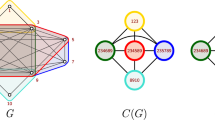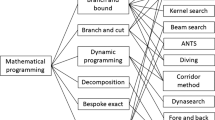Abstract
The purpose of this paper is to survey techniques for constructing effective policies for controlling complex networks, and to extend these techniques to capture special features of wireless communication networks under different networking scenarios. Among the key questions addressed are:
-
(i)
The relationship between static network equilibria, and dynamic network control.
-
(ii)
The effect of coding on control and delay through rate regions.
-
(iii)
Routing, scheduling, and admission control.
Through several examples, ranging from multiple-access systems to network coded multicast, we demonstrate that the rate region for a coded communication network may be approximated by a simple polyhedral subset of a Euclidean space. The polyhedral structure of the rate region, determined by the coding, enables a powerful workload relaxation method that is used for addressing complexity—the relaxation technique provides approximations of a highly complex network by a far simpler one.
These approximations are the basis of a specific formulation of an h-MaxWeight policy for network routing. Simulations show a 50% improvement in average delay performance as compared to methods used in current practice.
Similar content being viewed by others
References
Ahlswede, R., Cai, N., Li, S.-Y.R., Yeung, R.W.: Network information flow. IEEE Trans. Inf. Theory 46, 1024–1016 (2000)
Bertsekas, D.P.: Dynamic Programming and Optimal Control, 3rd edn. Athena Scientific, Nashua (2007)
Bertsimas, D., Niño-Mora, J.: Restless bandits, linear programming relaxations, and a primal-dual index heuristic. Oper. Res. 48(1), 80–90 (2000)
Bramson, M., Williams, R.J.: Two workload properties for Brownian networks. Queueing Syst. Theory Appl. 45(3), 191–221 (2003)
Brockmeyer, E., Halstrøm, H.L., Jensen, A.: The Life and Works of A.K. Erlang. The Copenhagen Telephone Company, Copenhagen (1948)
Bui, L., Srikant, R., Stolyar, A.: Novel architectures and algorithms for delay reduction in back-pressure scheduling and routing. arXiv:0901.1312. A short version of this paper is accepted to the INFOCOM 2009 Mini-Conference, Jan 2009
Candogan, U.O., Menache, I., Ozdaglar, A., Parrilo, P.A.: Competitive scheduling in wireless collision channels with correlated channel state. In: Proceedings of the International Conference on Game Theory for Networks (GameNets), 13–15 May 2009
Chen, W., Huang, D., Kulkarni, A., Unnikrishnan, J., Zhu, Q., Mehta, P., Meyn, S., Wierman, A.: Approximate dynamic programming using fluid and diffusion approximations with applications to power management. In: Proceedings of the 48th IEEE Conference on Decision and Control, 16–18 December 2009 (to appear)
Coffman, E.G. Jr., Mitrani, I.: A characterization of waiting times realizable by single server queues. Oper. Res. 28, 810–821 (1980)
Cover, T.M.: Comments on broadcast channels. IEEE Trans. Inf. Theory 44(6), 2524–2530 (1998)
Cover, T.M., Thomas, J.A.: Elements of Information Theory. Wiley, New York (1991)
Ephremides, A., Hajek, B.E.: Information theory and communication networks: an unconsummated union. IEEE Trans. Inf. Theory 44(6), 2416–2434 (1998)
Erlang, A.K.: Solution of some problems in the theory of probabilities of significance in automatic telephone exchanges. In: Brockmeyer, E., Halstrøm, H.L., Jensen, A. (eds.) The Life and Works of A.K. Erlang, p. 189. The Copenhagen Telephone Company, Copenhagen (1948). Originally published in Danish in Elektrotkeknikeren, vol. 13 (1917)
Erlang, A.K.: The theory of probabilities and telephone conversations. In: Brockmeyer, E., Halstrøm, H.L., Jensen, A. (eds.) The Life and Works of A.K. Erlang, p. 131. The Copenhagen Telephone Company, Copenhagen (1948). Originally published in Danish in Nyt Tidsskrift for Matematik B (1909)
Eryilmaz, A., Ozdaglar, A., Modiano, E.: Polynomial complexity algorithms for full utilization of multihop wireless networks. In: Proceedings of IEEE INFOCOM (2007)
Georgiadis, L., Neely, M., Tassiulas, L.: Resource Allocation and Cross Layer Control in Wireless Networks. Foundations and Trends in Networking, vol. 1(1). Now Publishers, Hanover (2006)
Gupta, G.R., Shroff, N.B.: Delay analysis for multi-hop wireless networks. In: Proceedings of IEEE Infocom, Rio de Janeiro, Brazil (2009). Presentation given at ITA-Workshop 2009, UCSD
Henderson, S.G., Meyn, S.P., Tadić, V.B.: Performance evaluation and policy selection in multiclass networks. Discrete Event Dyn. Syst. Theory Appl. 13(1–2), 149–189 (2003). Special issue on learning, optimization and decision making (invited)
Ho, T., Médard, M., Effros, M., Karger, D.: On randomized network coding. In: Proc. 41st Allerton Annual Conference on Communication, Control and Computing, October 2003
Ho, T., Medard, M., Koetter, R., Karger, D.R., Effros, M., Shi, J., Leong, B.: A random linear network coding approach to multicast. IEEE Trans. Inf. Theory 52(10), 4413–4430 (2006)
Jaggi, S., Sanders, P., Chou, P.A., Effros, M., Egner, S., Jain, K., Tolhuizen, L.M.G.M.: Polynomial time algorithms for multicast network code construction. IEEE Trans. Inf. Theory 51(6), 1973–1982 (2005)
Johannsen, F.W.: Waiting times and number of calls. P.O. Electr. Eng. J. (1907)
Kelly, F.P., Laws, C.N.: Dynamic routing in open queueing networks: Brownian models, cut constraints and resource pooling. Queueing Syst. Theory Appl. 13, 47–86 (1993)
Kleinrock, L.: Queueing Systems. Vol. 1: Theory. Wiley, New York (1975)
Kumar, S., Kumar, P.R.: Performance bounds for queueing networks and scheduling policies. IEEE Trans. Automat. Contr. AC-39, 1600–1611 (1994)
Kumar, P.R., Meyn, S.P.: Duality and linear programs for stability and performance analysis queueing networks and scheduling policies. IEEE Trans. Automat. Contr. 41(1), 4–17 (1996)
Laws, N.: Dynamic routing in queueing networks. Ph.D. Thesis, Cambridge University, Cambridge, UK (1990)
Lippman, S.: Applying a new device in the optimization of exponential queueing systems. Oper. Res. 23, 687–710 (1975)
Meyn, S.: Stability and asymptotic optimality of generalized MaxWeight policies. SIAM J. Control Optim. 47(6), 3259–3294 (2009)
Meyn, S.P.: The policy iteration algorithm for average reward Markov decision processes with general state space. IEEE Trans. Automat. Contr. 42(12), 1663–1680 (1997)
Meyn, S.P.: Stability and optimization of queueing networks and their fluid models. In: Mathematics of Stochastic Manufacturing Systems, Williamsburg, VA, 1996, pp. 175–199. Am. Math. Soc., Providence (1997)
Meyn, S.P.: Sequencing and routing in multiclass queueing networks. Part II: Workload relaxations. SIAM J. Control Optim. 42(1), 178–217 (2003)
Meyn, S.P.: Dynamic safety-stocks for asymptotic optimality in stochastic networks. Queueing Syst. Theory Appl. 50, 255–297 (2005)
Meyn, S.P.: Control Techniques for Complex Networks. Cambridge University Press, Cambridge (2007)
Modiano, E., Shah, D., Zussman, G.: Maximizing throughput in wireless networks via gossiping. In: Proceedings of ACM Sigmetrics/IFIP Performance (2006)
Shah, D., Wischik, D.: Lower bound and optimality in switched networks. In: Proceedings of the 46th Annual Allerton Conference on Communication, Control, and Computing, pp. 1262–1269, Sept. 2008
Srikant, R.: The Mathematics of Internet Congestion Control. Systems & Control: Foundations & Applications. Birkhäuser Boston, Boston (2004)
Subramanian, V., Leith, D.: Draining time based scheduling algorithm. In: Proceedings of the 46th IEEE Conf. on Decision and Control, pp. 1162–1167 (2007)
Tassiulas, L., Ephremides, A.: Jointly optimal routing and scheduling in packet radio networks. IEEE Trans. Inf. Theory 38(1), 165–168 (1992)
Tassiulas, L., Ephremides, A.: Stability properties of constrained queueing systems and scheduling policies for maximum throughput in multihop radio networks. IEEE Trans. Automat. Contr. 37(12), 1936–1948 (1992)
Traskov, D., Heindlmaier, M., Medard, M., Koetter, R., Lun, D.S.: Scheduling for network coded multicast: a conflict graph formulation. In: Proceedings of the IEEE GLOBECOM Workshop, pp. 1–5 (2008)
Ying, L., Shakkottai, S., Reddy, A.: On combining shortest-path and back-pressure routing over multihop wireless networks. In: Proceedings of IEEE Infocom, Rio de Janeiro, Brazil, April 2009
Author information
Authors and Affiliations
Corresponding author
Rights and permissions
About this article
Cite this article
Chen, W., Traskov, D., Heindlmaier, M. et al. Coding and control for communication networks. Queueing Syst 63, 195 (2009). https://doi.org/10.1007/s11134-009-9148-3
Received:
Revised:
Published:
DOI: https://doi.org/10.1007/s11134-009-9148-3




